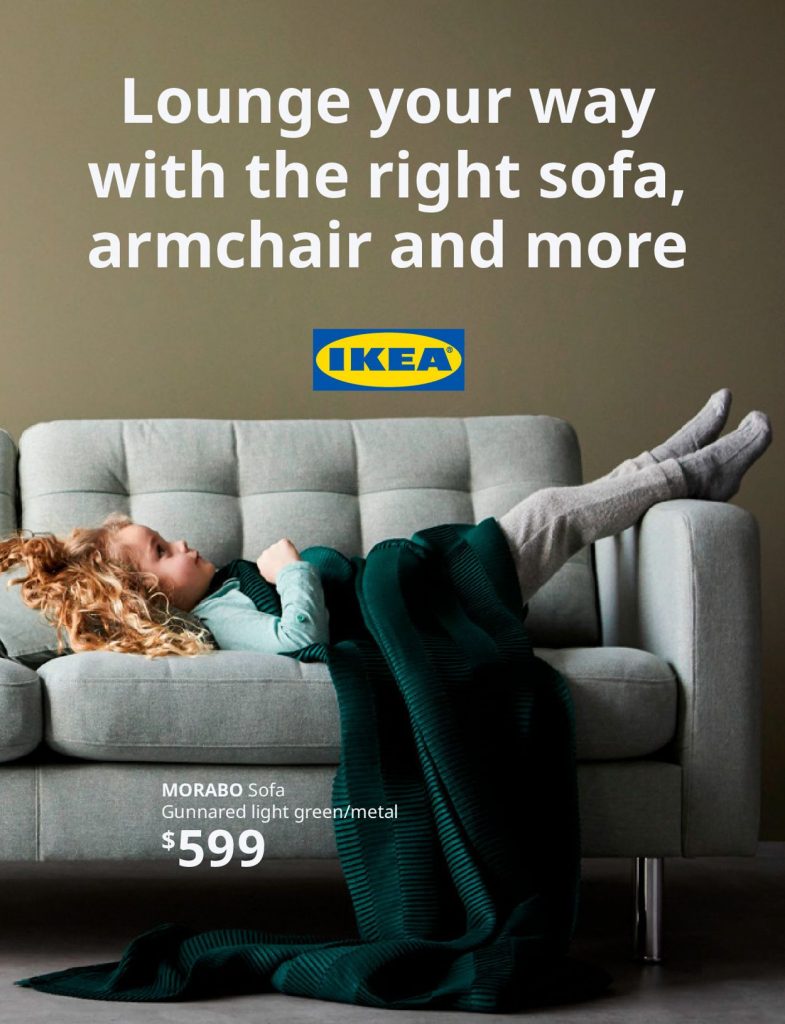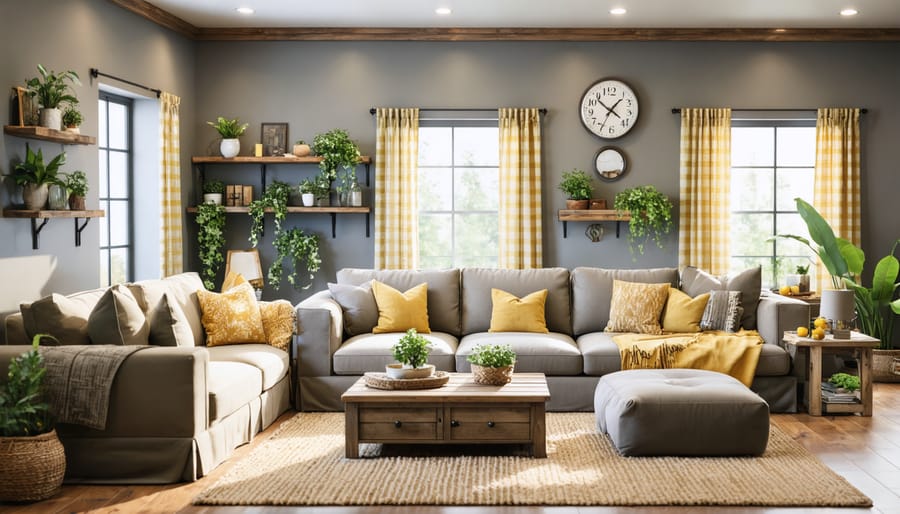
Find Your Perfect Couch: Everything Seasoned Buyers Wish They Knew
Choosing the perfect couch transforms your living space and impacts your daily comfort for years to come. Beyond style and color, a sofa represents a significant investment that demands careful consideration of durability, functionality, and lifestyle fit. From compact apartments to sprawling family rooms, the right couch serves as both a design anchor and a practical gathering spot for life’s important moments.
Smart couch shopping starts with understanding three crucial factors: space requirements, usage patterns, and material durability. A family of five with pets needs different considerations than a single professional in a studio apartment. Your sofa should complement your existing décor while standing up to your specific daily demands, whether that’s movie marathons, work-from-home sessions, or entertaining guests.
Before diving into showrooms or clicking through online catalogs, arm yourself with precise measurements, material knowledge, and a clear vision of your needs. This comprehensive guide will walk you through every essential consideration, helping you make a confident, informed decision that you’ll enjoy for years to come.
Couch Styles That Match Your Life
Modern Living Room Styles
Today’s living rooms come in various configurations to help you create a cozy living space that suits your lifestyle. Sectionals offer versatility and maximum seating, perfect for large families or those who love entertaining. These L- or U-shaped pieces can be configured to fit your room’s layout and often include features like recliners or chaise lounges.
Traditional sofas remain a popular choice, providing classic styling and comfortable seating for three to four people. Their straightforward design works well in both contemporary and traditional settings, making them a safe bet for most homes.
For smaller spaces or intimate seating areas, loveseats offer a compact solution without sacrificing style or comfort. These two-seater sofas work beautifully as companion pieces to larger sofas or as standalone seating in apartments and small rooms.
Sleeper sofas are the ultimate in functionality, transforming from everyday seating to a comfortable bed for overnight guests. Modern versions feature improved mechanisms and mattresses, making them both practical and comfortable for daily use.
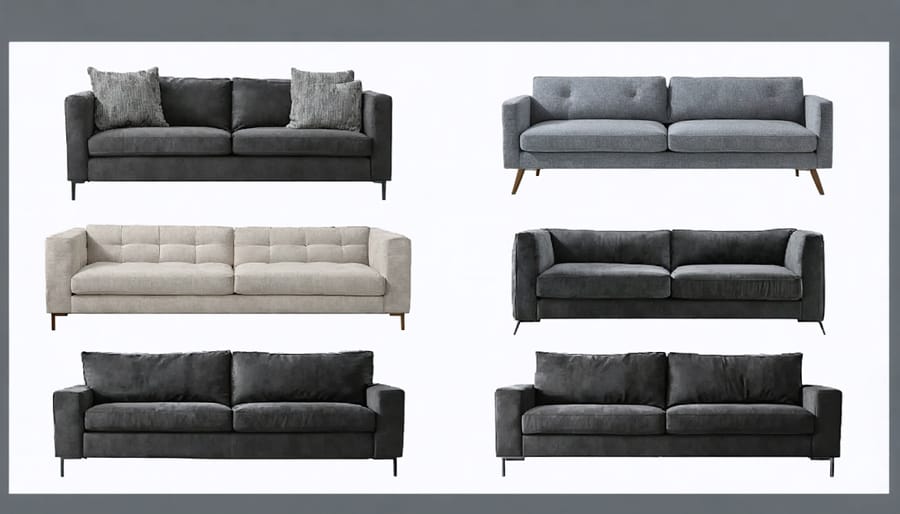
Space-Smart Solutions
Living in a compact space doesn’t mean compromising on comfort or style. Apartment-sized sofas offer the perfect balance, typically measuring between 68-80 inches wide, making them ideal for urban dwellings while maintaining full seating comfort. Consider modular sofas, which allow you to add or remove sections as needed – perfect for those who move frequently or like to change their layout seasonally.
Convertible pieces are game-changers for small spaces. Modern sleeper sofas have evolved far beyond the clunky metal-bar designs of the past, now featuring memory foam mattresses and smooth mechanisms that transform your couch into a comfortable bed in seconds. Look for innovative options like loveseat sleepers or sectionals with built-in storage compartments under the seats.
For ultimate flexibility, explore modular options with movable ottomans that can serve as extra seating, coffee tables, or footrests. Some clever designs even include charging ports and laptop tables that tuck away when not in use. Remember to measure your space carefully, including doorways and elevators, to ensure your space-saving solution can actually make it into your home.
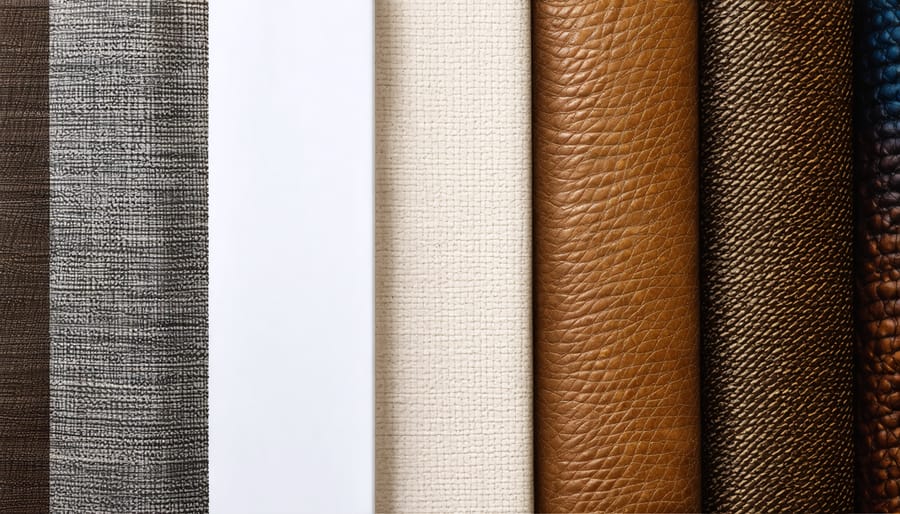
Materials Matter: Fabric vs. Leather
Fabric Options and Durability
When choosing your couch’s fabric, durability and maintenance requirements should be top priorities alongside aesthetics. Performance fabrics like polyester and nylon offer excellent resistance to wear and stains, making them ideal for high-traffic areas and families with children. These synthetic materials are often cheaper than natural fibers and maintain their appearance longer with proper care.
For those seeking luxury, natural fibers like cotton and linen provide breathability and comfort but require more maintenance. Leather remains a popular choice, offering both elegance and durability, though it needs regular conditioning to prevent cracking. If you have pets, consider exploring pet-friendly fabric options that resist scratches and are easy to clean.
Microfiber has gained popularity for its soft texture and impressive stain resistance. It’s particularly suitable for households with allergies as it doesn’t trap dust like traditional fabrics. Velvet adds luxury but demands careful maintenance and may show wear patterns more quickly.
When evaluating fabric options, check the rub count rating – higher numbers indicate better durability. Most residential furniture should have at least 15,000 double rubs, while heavy-use pieces should exceed 30,000. Remember that lighter colors show wear more quickly than darker shades, regardless of the fabric type.
Leather Types and Care
When it comes to leather couches, understanding the different grades can help you make a smarter investment. Top-grain leather is the highest quality, offering excellent durability and a luxurious feel that develops a beautiful patina over time. Split leather, taken from the lower layers of the hide, is more affordable but less durable. Bonded leather, made from leather scraps mixed with synthetic materials, is the most budget-friendly option but may not last as long.
To keep your leather couch looking its best, regular maintenance is essential. Clean spills immediately with a soft, dry cloth, and avoid using harsh chemicals or excessive water. Apply a quality leather conditioner every 6-12 months to prevent cracking and maintain the material’s natural oils. Keep your leather furniture away from direct sunlight to prevent fading and drying.
Each type of leather ages differently. Full-grain and top-grain leather develop a rich character over time, with natural markings becoming more pronounced. Protected leather maintains a more consistent appearance but may not develop the same distinguished patina. Some leather types are more susceptible to scratches and wear patterns, which many consider adds to their charm and creates a lived-in look that tells your home’s story.
Remember to ask about the specific care requirements for your chosen leather type, as maintenance needs can vary significantly between grades.
Construction Quality Indicators
Frame and Support Systems
A couch’s frame and support systems are the backbone of its durability and comfort. Hardwoods like oak, maple, and ash are the gold standard for frame construction, offering superior strength and longevity compared to softwoods or engineered wood. Look for frames made from kiln-dried wood, which prevents warping and cracking over time.
Quality joinery methods are crucial for frame stability. Corner blocks, dowels, and mortise-and-tenon joints indicate excellent craftsmanship, while staples and glue alone should raise red flags. Double-doweled joints at stress points provide extra reinforcement where it’s needed most.
The suspension system determines how well your couch maintains its shape and comfort. Eight-way hand-tied springs represent the premium choice, offering superior support and weight distribution. Sinuous springs (S-shaped wire) are a reliable alternative, commonly found in mid-range couches. Web suspension, while more affordable, typically offers less support and may sag over time.
Test the frame’s sturdiness by lifting one corner – the entire couch should lift slightly. Listen for squeaks or creaks when sitting, as these could indicate poor construction. A well-built frame and support system should come with at least a 5-year warranty, reflecting the manufacturer’s confidence in their construction methods.
Cushion Fill Options
The fill material inside your couch cushions plays a crucial role in both comfort and longevity. High-density foam is the most common and practical choice, offering consistent support and maintaining its shape well over time. It’s available in different firmness levels, with softer options providing a plush feel and firmer varieties offering more support.
Down filling creates that coveted sink-in feeling and ultimate softness, but requires regular fluffing to maintain its shape. For a more practical alternative, down-blend wrapping combines a foam core with a down-alternative outer layer, delivering the best of both worlds – comfort and practicality.
Memory foam cushions conform to your body and spring back to shape, making them ideal for those seeking pressure-point relief. However, they can retain heat and might feel too conforming for some users.
Polyester fiber fill is budget-friendly and hypoallergenic but tends to lose shape quickly and may need frequent replacement. For environmentally conscious buyers, recycled foam or natural latex options provide eco-friendly alternatives while maintaining comfort and durability.
Consider your lifestyle when choosing – active households might prefer resilient foam, while those prioritizing luxury might opt for down-blend combinations.
Size and Placement Success
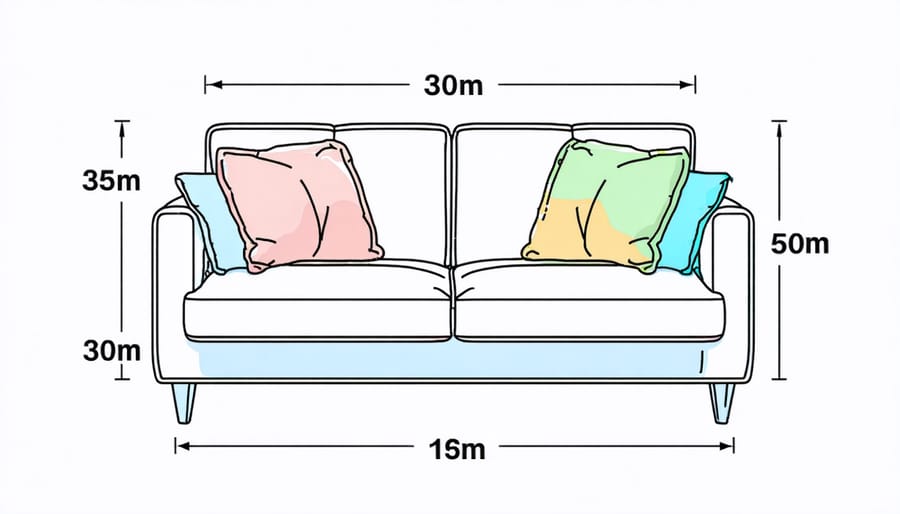
Room Measurements
Before shopping for your new couch, accurate room measurements are essential for a perfect fit. Start by measuring the room’s length and width, then create a basic floor plan on graph paper or using a room planning app. Mark existing furniture, windows, doorways, and traffic paths.
For the couch space itself, measure the maximum length and depth available, keeping at least 30 inches of walking space around the furniture. Don’t forget to measure doorways, hallways, and stairwells – these are crucial for delivery day. For tight spaces or apartments, measure the elevator dimensions and any sharp turns.
Pro tip: Use painter’s tape to outline your potential couch dimensions on the floor. This helps visualize how the piece will fit and flow in your space. Consider the couch’s orientation and how it affects traffic flow and conversation areas.
Remember to account for reclining features if you’re considering motion furniture, as these require additional clearance space. Also, factor in side tables, coffee tables, and other accompanying pieces that will share the space with your new couch.
Traffic Flow Planning
Before placing your new couch, carefully consider how it will affect movement through your room. A well-planned traffic flow ensures your space remains functional and comfortable. Start by mapping out the main pathways people use to move through the room, typically between doorways, to other furniture pieces, and toward windows or focal points.
Leave at least 30 inches of walking space around your couch for comfortable movement. In high-traffic areas, aim for 36-48 inches to prevent congestion. Consider how the couch placement affects access to other furniture pieces and features like TV viewing angles, conversation areas, and natural light sources.
For open-concept spaces, use your couch to define separate zones while maintaining clear pathways between areas. If you’re working with a smaller room, consider a loveseat or apartment-sized sofa that won’t obstruct movement. Remember that L-shaped sectionals can help direct traffic flow naturally around the room, while floating furniture arrangements (placing the couch away from walls) can create multiple pathway options.
Pay special attention to entry points – ensure your couch doesn’t create a bottleneck near doorways or hallways. This thoughtful planning will make your space more enjoyable and easier to navigate daily.
Smart Shopping Strategies
When to Buy
Timing your couch purchase strategically can lead to significant savings, especially when furniture shopping on a budget. The best deals typically appear during major holiday weekends, with Presidents’ Day, Memorial Day, and Labor Day sales offering discounts of up to 30-40% off regular prices. If you’re furnishing your first home, these sales events are perfect opportunities to maximize your budget.
Indoor furniture retailers often introduce new collections in February and August, making January and July excellent months to find clearance deals on previous season’s models. Additionally, many stores offer end-of-year sales in December to clear inventory before the new year.
For the absolute best prices, consider shopping during the “off-season” – buying indoor furniture during summer months when outdoor furniture is in higher demand. You’ll find fewer shoppers competing for deals and more motivated salespeople willing to negotiate.
Pro tip: Sign up for retailer newsletters and follow their social media accounts several weeks before you plan to buy. Many stores offer exclusive subscriber discounts and early access to sales events, giving you an advantage in securing the best deals before inventory runs low.
Warranty and Return Policies
When shopping for a couch, understanding warranty coverage and return policies is crucial for protecting your investment. Most quality manufacturers offer warranties ranging from 1 to 10 years, with premium brands often providing lifetime coverage on frame and springs. Look for warranties that specifically cover structural elements, including frame integrity, spring systems, and cushion resilience.
Be wary of warranties that only cover manufacturing defects, as they might not address common issues like fabric wear or cushion sagging. Many retailers offer additional protection plans for an extra cost, which can be worthwhile for high-end pieces or homes with children and pets.
Return policies vary significantly between retailers. Traditional brick-and-mortar stores typically allow 14-30 days for returns, while online retailers might extend this to 60-100 days to accommodate the “try-before-you-buy” nature of online shopping. Always check if return shipping is included for online purchases, as furniture return costs can be substantial.
Take photos when your couch arrives and immediately report any damage or defects. Keep all documentation, including warranty cards, receipts, and delivery paperwork. Some retailers charge restocking fees or require original packaging for returns, so clarify these details before purchasing.
Choosing the perfect couch is a significant investment that requires careful consideration of multiple factors. Throughout this guide, we’ve covered essential aspects from measuring your space and determining your lifestyle needs to selecting the right materials and understanding construction quality. Remember to prioritize both comfort and durability while staying within your budget. When making your final decision, focus on finding a balance between aesthetic appeal and practical functionality.
Take time to test your potential couch in person whenever possible, and don’t rush the decision-making process. Consider factors like maintenance requirements, warranty coverage, and delivery options before making your purchase. If you’re buying online, carefully review return policies and customer reviews.
For the best long-term satisfaction, invest in quality construction and durable materials that match your lifestyle. Whether you choose a classic leather sectional or a modern fabric sofa, ensuring proper fit, comfort, and durability will help you make a choice you’ll enjoy for years to come. Remember, the perfect couch isn’t just about style – it’s about creating a comfortable, functional centerpiece for your living space.
